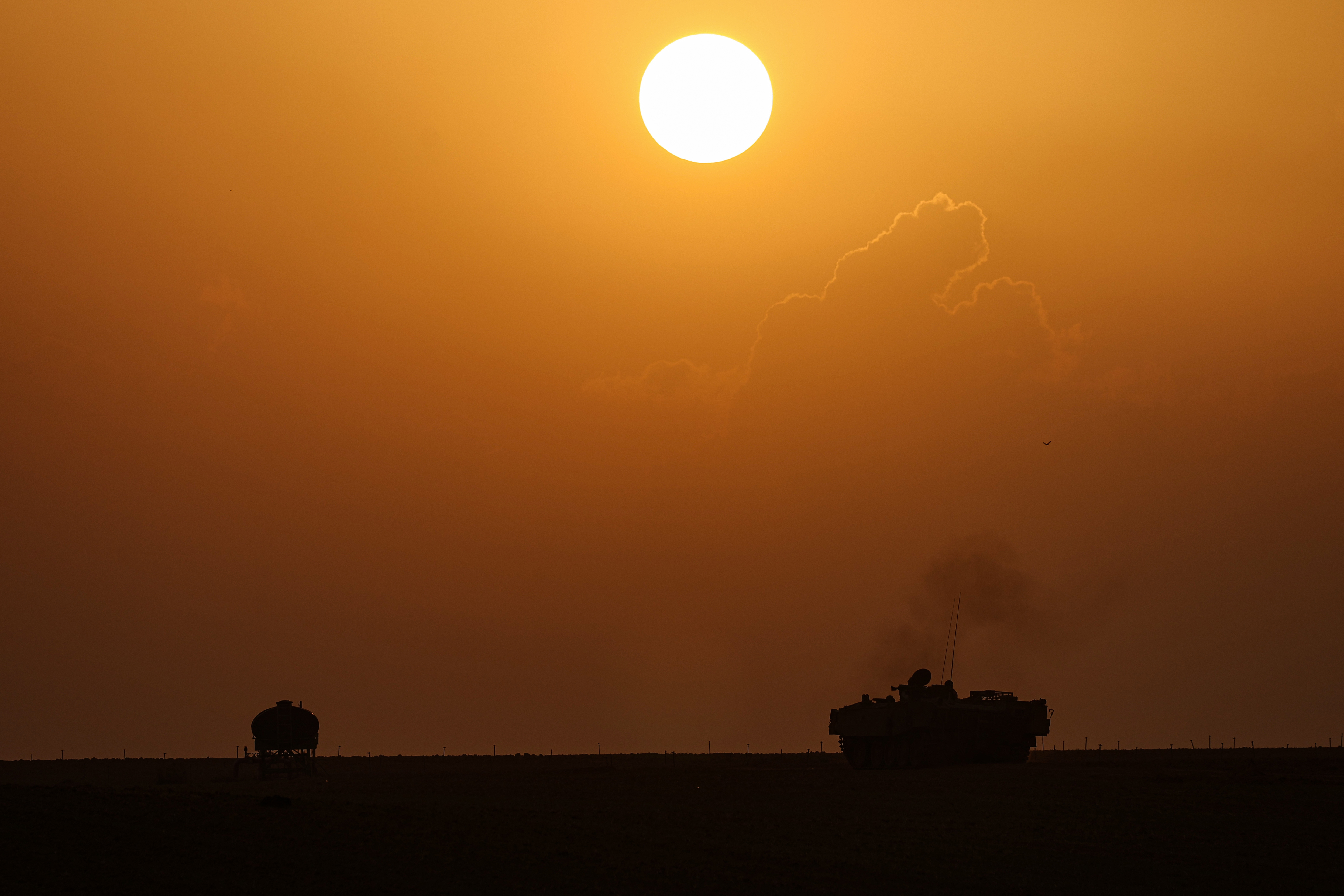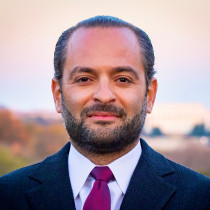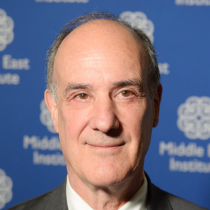
A brief look back at 2023: From normalization to escalation in the Middle East
Alistair Taylor
Editor-in-Chief

With the war in Gaza and its regional reverberations dominating news coverage, international fora, and policy discussions about the Middle East over the past several months, it’s easy to forget that for most of the year the prevailing trend shaping the region was a broader shift toward de-escalation, rapprochement, and normalization of ties. Driven in part by a widespread perception of growing US disengagement from the Middle East and Washington’s increasing unreliability, regional actors took steps to address their own concerns. The March 2023 normalization agreement between long-time regional rivals Saudi Arabia and Iran was perhaps the clearest illustration of this (even if the deal was nominally brokered by Beijing). This trend was also evident, however, in the Turkish rapprochement with Saudi Arabia, the United Arab Emirates, Egypt, and (fleetingly) Israel; the controversial push by some Arab states to bring Syria’s Bashar al-Assad back in from the cold following the country’s 12-year-long civil war; and the ongoing talks between Saudi Arabia and the Iran-backed Houthis in Yemen.
At the same time, throughout much of 2023 there was a strong countervailing trend as tensions persisted between certain key actors and in some cases spiked. The civil wars in Yemen, Libya, and Syria dragged on, even if they remained largely frozen. But a new conflict broke out in Sudan in mid-April, pitting the Sudanese Armed Forces against the paramilitary Rapid Support Forces. Often forgotten in Washington, the civil war in this key northeast African state has, to date, seen more than 12,000 people killed and 6.6 million forcibly displaced, both internally and within the region. Further afield, Russia’s war on Ukraine continued to impact the Middle East and North Africa as well, especially in terms of regional food security, even as Iran grew closer to Russia, ratcheting up its material support for Moscow’s war effort. The South Caucasus saw renewed fighting too, with Azerbaijan recapturing Karabakh in a military operation in September following a months-long blockade, a move that will likely consolidate close Baku ally Ankara’s influence in the region at the expense of Moscow and Tehran.
Although its bandwidth was constrained by a focus on China and the Russo-Ukrainian war, the Biden administration pursued efforts over the course of the year to advance new “minilateral” and multilateral diplomatic initiatives to further regional economic integration. Those have included the Negev Forum, the I2U2 grouping (comprising India, Israel, the US, and the UAE), and the India-Middle East-Europe Economic Corridor, as well as efforts to build on the Trump-era Abraham Accords by securing a Saudi-Israeli normalization agreement (hampered but clearly not derailed by the radical policies of Israel’s far-right government and the rise in violence in the West Bank). The Hamas-led attack on Israel on Oct. 7 and the subsequent war in Gaza have raised major question marks about the future of these initiatives, and indeed of US policy toward the region more broadly. While it is uncertain what the new year will bring, it seems unlikely to be the “quieter” Middle East top US officials were touting earlier this fall.
Macro trends remain largely unchanged
Long tail of Israel-Hamas war will overshadow 2024
Paul Salem
President and CEO

Before Oct. 7, the region was trending toward de-escalation, normalization, and the mantra of “It’s the economy, stupid.” Today, the Israeli-Palestinian conflict has come raging back, and concomitantly, conflict between Iran and its proxies on the one hand, and the United States on the other, has escalated as well. How the Gaza war is brought to an end, and what comes after it, will have a profound impact on the contours of the region in 2024.
If the war ends with a renewed Israeli occupation of Gaza and a ramped-up expansion of settlements in the West Bank, the momentum toward further normalization with Israel will slow and Arab public opinion will solidify against it; at the same time, the US will face headwinds in its regional relations. Iran and its proxies, as well as radical Sunni extremist groups, will benefit from this polarization and gain more adherents and influence. On the other hand, if the war is followed by a robust peace effort, led by the US but including key global and regional players, the region could turn in a much more positive direction, leaving radicals and spoilers on the sidelines.
At the national level, little political change is to be expected, despite the organization of national — largely sham — elections in Egypt (December 2023), Tunisia, Algeria, and Iran. But it is worth keeping a close eye on Israel, where Benjamin Netanyahu and his far-right government are unlikely to survive 2024, and on Iran, where the death of the supreme leader — whenever it happens — will raise important and immediate questions about the new leadership and direction of the Islamic Republic, or possibly its survival in its previous form.
Economically, the region will remain extremely uneven. The International Monetary Fund estimates an overall GDP growth rate of 3.4%, up from 2% in 2023, but this will belie great wealth and income inequalities between the Gulf Cooperation Council countries at the top of the pyramid and nearby neighbors, like Yemen or Syria, that languish at the very bottom. In between, middle-income states will struggle to reduce unemployment and inflation while carrying large debt burdens. Egypt and Jordan, particularly, will face daunting combinations of socio-economic and political challenges.
When it comes to the region’s ongoing civil wars, Libya, Syria, and Yemen might hopefully remain largely frozen, but the conflict in Sudan will continue to worsen. Alongside important efforts to tackle the Israeli-Palestinian conflict with robust and bold diplomacy, endeavors to de-escalate or end the four aforementioned civil wars should also be redoubled.
Follow: @paul_salem
Bandwidth challenges, self-deterrence impulses, and partisan rancor will impact US Middle East policy
Brian Katulis
Vice President of Policy

Looking ahead to 2024, the United States faces no shortage of challenges in the broader Middle East: an active, ongoing war between Israel and Hamas in the Gaza Strip, chronic human security challenges straining the region's state system, and persistent threats from both Iran and its network of proxies as well as terrorist networks like the remnants of the Islamic State, among others.
But some of the biggest challenges to US foreign policy in the Middle East in the new year may come from within. America’s policy apparatus and political system may end up being one of its own worst adversaries when it comes to advancing a coherent strategy in the region, on three important fronts.
First, the Biden administration is experiencing some major operational bandwidth challenges in its national security apparatus. Combined with a lack of strategic focus and clear priorities in its overall foreign policy, this could hamper America’s ability to advance a more engaged strategy across the broader Middle East. Russia’s ongoing war against Ukraine and China’s actions in Asia and around the world will continue to take up much time and attention, too.
Second, the basic impulse of the Biden administration to avoid adopting a more proactive stance in its diplomatic and military approaches across the Middle East, driven in part by the bandwidth constraints, may prolong conflicts like the Israel-Hamas war. It could also close off opportunities in the short run for advancing some of the more proactive engagement steps the Biden administration was pursuing before Oct. 7, including expanding the work of the Negev Forum, exploring the possibilities for normalization between Saudi Arabia and Israel, and taking steps toward implementing concepts like the India-Middle East-Europe Economic Corridor (IMEC).
Lastly, 2024 is an election year, and the presidential match-up, along with the race for seats in both the House and Senate in November, will usher in the usual partisan rancor about nearly every issue in the public sphere, including on Middle East policy. The impulse to make US foreign policy a partisan wedge issue in America’s domestic politics remains quite strong. This election year may prove no different, and may in fact be more convoluted due to thorny intra-party divisions among Republicans and Democrats on some Middle East policy questions. The different voices that will emerge in this complicated political debate are bound to send mixed signals to friends and foes alike in the Middle East, and fears of a pendulum swing in power by 2025 may incentivize key actors in the region to continue to hedge their bets.
The United States faces no shortage of threats in the Middle East, but one of the biggest things that might hold it back are the challenges it faces from within its own politics.
Follow: @Katulis
MENA’s economic outlook is weakening and fraught with uncertainty
Shahrokh Fardoust
Non-Resident Scholar

In their October 2023 outlooks for the Middle East and North Africa region, both the International Monetary Fund (IMF) and the World Bank project a sharp slowdown in the region’s annual economic growth in 2023, to 2%, down from nearly 6% in 2022, as a result of cutbacks in oil production in some Gulf Cooperation Council countries to prevent further declines in oil prices. Both institutions project GDP growth will remain far below 2022 levels in 2024, rising to just 3.5%, driven mainly by non-oil economic activity.
The war in Gaza is adversely affecting growth and financial conditions in several countries and has significantly dimmed the region’s economic outlook for 2024. A recent note from IMF staff indicated that the Fund is lowering its growth forecast for MENA, adding that a large-scale conflict, presumably involving several states, is likely to constitute a major economic challenge for the entire region in 2024 and beyond.
The economies of countries and territories directly involved in the war — Israel and the West Bank and Gaza — are already being hit hard. A recent report by the United Nations Development Programme projects that if the conflict lasts three months, the combined GDP of the West Bank and Gaza is likely to fall by more than 12%, and the number of those in poverty could rise by 45%. Given that half of the housing in Gaza has been destroyed, three-quarters of its population has been displaced, and more than 17,000 of its residents have been killed, the economic impact on Gaza likely already exceeds a 50% decline in GDP, with its entire population facing a humanitarian disaster.
If the conflict does not escalate to the regional level, Israel’s growth is forecast to drop somewhat, mainly as a result of declines in private consumption, investment, and tourism, from an average of 3.0% a year forecast for 2023-24 prior to the conflict to 2.3% in 2023 and 1.5% in 2024, according to the Organization of Economic Co-operation and Development (OECD). Its healthy economy before the conflict, adequate fiscal and balance-of-payments buffers, and quick policy response are expected to prevent more serious damage, absent further escalation.
The tourism sector accounts for 35-50% of export revenues in Egypt, Jordan, and Lebanon and is a critical source of foreign exchange and employment. It has been badly hurt by the war, which has also slowed inflows of foreign direct and portfolio investments, because of increased uncertainty, higher perceived risks for businesses and households, and tightening of financial conditions. If the conflict persists and expands, the economic impact is likely to be substantially greater for all parties involved and is likely to extend far beyond the current area of conflict, shaving off at least 4-5 percentage points from pre-conflict economic growth projections for 2024.
The world economy is in a better position to absorb a major oil price shock than it was in the early 1970s. But a widening of the Israel-Hamas war could result in a substantial (albeit temporary) reduction in oil and gas supplies in one or more producers in the region. A temporary blockage of the Suez Canal or the Strait of Hormuz or damage to energy facilities could significantly reduce the GDP of major oil and gas producers in the region and have harsh consequences for the world economy.
Even a temporary reduction in oil and gas supplies could lead to large increases in energy prices. Such increases, which come on top of energy and food supply disruptions caused by the 2022 Russian invasion of Ukraine, could push global commodity markets into uncharted waters. According to the World Bank’s latest commodity outlook, disruption comparable to the 1973 Arab oil embargo could reduce the global oil supply by as much as 6-8 million barrels per day, initially raising prices by 56-75% (to $140-157 a barrel).
The global economy has become much less oil intensive than it was in the 1970s. Despite this, macroeconomic model simulations indicate that for each $10 per barrel increase in oil prices, global growth could decline by 0.1% and global inflation could increase by 0.2%. According to a recent report by the OECD, a large oil price shock caused by blockage of major shipping routes could disrupt trade flows and reduce asset prices worldwide, turning the projected “soft landing” of advanced economies (which are currently projected to grow by 1.4% in 2024) into stagflation, with falling output and rising inflation.
Twin inflection points will cast a shadow over the Middle East’s cyber and tech landscape
Mohammed Soliman
Director, Strategic Technologies and Cyber Security Program

In 2024, two key inflection points will cast a shadow over the cyber and technology landscape in the Middle East: the US-China Tech Cold War and the ongoing Israel-Hamas war. The United States increasingly views its bilateral relations with allies and partners through the lens of its competition with China. Consequently, Washington is expected to heighten pressure on allies like Saudi Arabia, Israel, and the United Arab Emirates to restrict cooperation with China, especially in strategic technologies such as artificial intelligence (AI). This trend is exemplified by recent US Department of Commerce rules aimed at preventing Chinese access to Nvidia and AMD AI chips through third countries, which may eventually impact Saudi Arabia and the UAE’s efforts to develop their own large language models for AI applications. Such developments could influence the digital transformation goals of these Gulf states, which place a high value on AI capabilities. Additionally, the American intelligence community will continue to scrutinize China’s technology cooperation with Gulf partners, highlighting the increasing centrality of tech issues in US bilateral relations with these states.
Moving beyond the matters of China and the Gulf, 2024 is also likely to witness a continuing proliferation of cyberweapon use as a result of the Israel-Hamas war and, by extension, as part of the Iran-Israel standoff. Israel and Iran have engaged in cyberwarfare for years, employing tools such as ransomware and distributed denial-of-service (DDoS) attacks to compromise intelligence databases or even cripple physical infrastructure. As Israel’s military campaign in Gaza has progressed, Iranian cyberattacks against Israel have increased in frequency and sophistication. In the coming year, Israel will probably seek to recalibrate its cyber doctrine to more effectively challenge and deny Iranian cyber offensive capabilities and inflict harm on Iranian infrastructure as a consequence. However, Moscow is likely to continue to build up Iranian cyber capabilities in return for Iranian industrial and military support for Russia’s war against Ukraine. As a result, Iran may not be as easy a cyber domain opponent for Israel as it once was.
Finally, the Israel-Hamas war has unleashed a deluge of multi-platform misinformation and disinformation across the Middle East and around the world. From TikTok to X, and from Facebook to Instagram, the sheer volume of available war-related media, coupled with the number of social media platforms on which to share content and the charged nature of the issue, has opened an unprecedentedly wide “virtual front” of the conflict that will continue to drive the spread of false and misleading information well into 2024. State and non-state actors alike will look back on this war for years to come to draw lessons on how to utilize social media to galvanize support for their own narratives in times of conflict, elections, domestic and regional political tensions, and geopolitical stand-offs.
Follow: @ThisIsSoliman
War in Gaza reverberates across region
Israel’s direction will be shaped by Gaza war, domestic politics, and regional relations
Nimrod Goren
Senior Fellow for Israeli Affairs

The year 2023 began with a grim outlook for Israel, following the establishment of the most right-wing government in its history. Expectations for Israeli-Palestinian escalation, democratic backsliding, and a slowdown in Israel-Arab relations have all come true. The year 2024 will also start off on a difficult footing, as Israel continues to recover from the brutal Hamas terror attack of Oct. 7 and is in the midst of a war in Gaza.
Looking further ahead, the scenarios are mixed. The downward spiral of developments might continue, but the current dire reality also creates new opportunities for a different path — domestically, with the Palestinians, and regionally. Whatever scenario will eventually materialize will have a long-term impact on Israel's well-being, national identity, and foreign relations.
The key factors that will shape Israel’s direction are the fate of the war in Gaza and its consequences, a possible domestic political transformation, and the evolution of relations with Arab countries. Global developments will also play a key role, especially in the lead up to and aftermath of the US presidential elections in November.
The war in Gaza is likely to still be in its high-intensity fighting phase as 2024 begins. Israel’s objectives include ensuring that Hamas does not govern the Gaza Strip and no longer poses a security threat, as well as securing the release of the hostages it holds. Should Israel succeed in achieving these goals, a transition phase will probably commence. Regional and international actors will make efforts — in coordination with Israel — to create a modality allowing for the administration and reconstruction of the Gaza Strip, the revitalization of the Palestinian Authority, and its return to Gaza. Should Israel not succeed in achieving its main objectives, fighting is likely to continue, albeit at varying levels of intensity, amid ongoing regional instability and the risk of further escalation.
Israel is likely to see a domestic political transformation as well. Public opinion was already shifting before Oct. 7, with resentment of the Netanyahu government growing over its attempts to overhaul the judiciary. After Oct. 7, anger intensified and a large majority of Israelis are now calling on Prime Minister Benjamin Netanyahu to resign. The war has shifted the Israeli mindset further to the right while also creating a yearning for more centrist and responsible leadership. New political configurations and leaders are likely to emerge, on both the left and the right. Political rivals will find themselves sharing the goals of ousting Netanyahu, countering far-right parties, and getting Israel back on track, creating new opportunities for cooperation and possibly leading to unexpected alliances.
On the regional level, the Gaza war has so far underscored the resilience of Israel's relations with those Arab countries with which it has signed peace and normalization agreements. In 2024, Israel will need to pay special attention to its strategic relations with Egypt and Jordan, in light of tensions that have emerged over the Gaza war. Israel will probably try to enhance cooperation with the United Arab Emirates and Bahrain, continue the gradual advancement of ties with Saudi Arabia, and engage with Qatar on hostage-related mediation. Specifically, it will hope to see greater Emirati and Saudi involvement in shaping the future of Gaza and the Palestinian leadership, given Qatar’s close ties with Hamas.
Follow: @GorenNimrod
Amid deadly Gaza war and growing West Bank violence, a bleak outlook for Palestinians
Khaled Elgindy
Senior Fellow, Director of Program on Palestine and Palestinian-Israeli Affairs

Looking ahead to 2024, the outlook for Palestine and Palestinians has never been more bleak. Israel’s assault on Gaza, which has now entered its third month and shows no sign of letting up, is already the deadliest event and the largest forced displacement of Palestinians in history. The war has killed 17,000 people, mostly civilians, including 7,200 children; violently displaced 1.8 million of Gaza’s population of 2.3 million; and led to the destruction of most of its civilian infrastructure and housing. Meanwhile, Israel’s cut-off of water, food, fuel, and medical supplies to Gaza’s population, along with the collapse of the health care system, have led to what UN officials describe as an “epic humanitarian catastrophe,” while warning that disease and starvation could cause as many deaths as the two months of bombing.
With the world’s attention focused on the carnage in the Gaza Strip, Palestinians in the occupied West Bank are also facing unprecedented and growing levels violence at the hands of the Israeli army and extremist Jewish settlers. Since Oct. 7, Israeli army incursions and mass arrests have intensified across the West Bank, resulting in the death of 265 Palestinians and the arrest of more than 3,000. At least 9 Palestinians have been killed and over 1,000 Palestinians have been forced to flee their homes in the West Bank due to attacks by Israeli settlers.
The Israeli assault on Gaza, along with Israeli army and settler violence in the West Bank, are likely to continue into 2024. Israel has promised to press ahead with its war on Gaza for at least several more weeks, an outcome made possible in large part by the Biden administration’s decision on Dec. 8 to cast the sole vote against a United Nations Security Council resolution calling for an immediate humanitarian ceasefire. Several more weeks of bombardment, combined with the spread of disease and starvation, could, as a worst case scenario, force large numbers of desperate Gazans over the border with Egypt — a goal that aligns with Prime Minister Benjamin Netanyahu’s desire to see a “thinning out” of Gaza’s population — as well tens of thousands more dead. Such a mass displacement of Palestinians outside their homeland would add a new layer to the Israel-Palestine conflict that would likely lead to decades of violence and instability and shatter hopes for a peaceful settlement for generations to come.
Either way, Israel’s war on Gaza is unlikely to dislodge Hamas or fully eliminate its military capabilities. Even after the current Israeli bombing campaign and ground operations end, the war is likely to enter a new phase of protracted, low-level insurgency between Israeli forces and armed Palestinian groups, which will complicate humanitarian relief efforts and likely derail international reconstruction efforts or the return of the Palestinian Authority (PA) to Gaza.
Moreover, the human and physical destruction inflicted on Gaza will take years if not decades to recover from, while its political implications will likely reverberate for generations. With the PA already in a state of slow-motion collapse, the catastrophe unfolding in Gaza and the growing crackdown in the West Bank have underscored the growing impotence and obsolescence of the current Palestinian leadership. In short, Palestinians are going into 2024 in state of unparalleled collective trauma, political upheaval, and leaderlessness.
Follow: @elgindy_
As Lebanon’s crises continue to mount, only accountability can save the country
Fadi Nicholas Nassar
U.S.-Lebanon Fellow

For nearly five years, Lebanon has routinely been described as a country suffering from concurrent crises. In 2019, it was hit by the worst financial and economic meltdown in its history as well as a massive social and political uprising. In 2020, the country faced two new crises as the global COVID-19 pandemic spread and the devasting Port of Beirut explosion destroyed the capital, killing hundreds and forcibly displacing hundreds of thousands. In the years that followed, a country once defined by its joie de vivre has become ruled by despair. The vast majority of its people live in multidimensional poverty with limited access to basic public services like electricity and clean water. The past year has seen Lebanon navigate these national emergencies with only a caretaker government and without a president, a central bank governor, and soon a head of the army. The Gaza war and its rapid spillover into Lebanon added one more new crisis to the country’s already overwhelming calamities: An active conflict and the real and present risk of a full-scale war with Israel, pushing the country further in its long decline into a failed, quasi-authoritarian state. The year 2024 is likely to bring more pain and uncertainty for Lebanon as it approaches an even more devastating phase of its crisis.
Wars are notoriously hard to predict, easy to start, and infinitely more difficult to end. The risk of a full-scale war between Hezbollah and Israel remains high, and the relative restraint that has prevented it so far should not be misconstrued. The Israeli defense minister's recently stated objective of securing a full Hezbollah pullback to the Litani River through diplomacy or force is a strong indicator that the ongoing conflict may yet break out into a full-scale war despite the fragile but far from certain “rules of engagement” on the battlefield. Meanwhile, developments in Lebanon, like Hamas' call for arming Palestinians in the country in the fight against Israel, continue to underscore its transformation into the headquarters and planning grounds of the so-called “Axis of Resistance.” The possibility of a full-scale conflict, either as a direct result of the Gaza war or in the future if Lebanon fully descends into a failed, authoritarian state, must be taken seriously as a critical matter of international peace and security.
As Lebanon adds a new category to its concurrent state of crises, there is little evidence that progress will be made in its ability to manage any of them. There can be no credible reforms without accountability for the economic meltdown, the management of the crisis, the Port of Beirut blast, and the victims of political violence. Consequently, Lebanon will further devolve into lawlessness, serving as a haven for fugitives from justice and run by a mafia-militia state sustained by a cash economy and fleeting remittances.
Against the backdrop of such tragedy, it may seem unfathomable that the situation could get even worse. Certainly, any war with Israel would be catastrophic. Even if a full-scale war can be averted, there seems to be little clarity as to how the ongoing (and intensifying) localized conflict will end. Nor is there any indication of work being done, let alone meaningful progress, to save Lebanon from its other grueling crises. On the contrary, as the many different victims of its painful history know all too well, these injustices will soon be normalized as a new and even more dysfunctional status quo is imposed on the Lebanese and further denies them their core rights and quality of life.
As 2024 approaches, it is tempting to dismiss all these problems as symptoms of deep systemic failures inherent to Lebanon and blame the Lebanese for not addressing the injustices suffocating their country. But Lebanon’s descent into a quasi-authoritarian state has not happened overnight or behind closed doors. The mass deployment of US warships to the region, including two carrier strike groups and a nuclear submarine, makes it clear that Lebanon matters and its coercion into failure is an issue of international peace and security. Its friends, both globally and regionally, must finally realize that Lebanon will serve as either a hub for development and progress or violence and instability. Despite its many challenges, the country still has a diverse majority that aspires to a functioning state, thriving economy, and participatory democracy. There are no quick fixes or piece-meal deals between mafia and militia to be negotiated that falsely promise to contain Lebanon’s dysfunction but inevitably push the entire region to the brink. Only accountability for Lebanon’s concurrent crises and its coercion into failure can save the country, deliver its many victims the justice they so deeply deserve, and put Lebanon back on its path to being a center for education, progress, and development.
Follow: @dr_nickfn
Egypt’s internal and external difficulties look set to continue
Mirette F. Mabrouk
Senior Fellow and Founding Director of the Egypt program

Forecasting the future is a deeply unreliable art at best, and a seriously misleading exercise at worst. In the case of Egypt, any hope of being able to accurately predict how the country might fare up to one year out evaporated the day Russia re-invaded Ukraine in February 2022.
At that point, Egypt’s economy began to strain at the seams. The war, though seemingly distant from Egypt, exposed serious flaws in the country’s economy, which was already struggling from the aftershocks of the COVID-19 pandemic. Egypt is the world’s largest grain importer, 80% of which came from Russia and Ukraine. The war disrupted supply while skyrocketing prices by 33.1%, adding almost $2 billion to Egypt’s already huge $3.2 billion grain subsidy budget and forcing Cairo to dig deeper into its foreign currency reserves to cover the difference. To exacerbate matters, the Russo-Ukrainian war brought to light Egypt’s reliance on hot capital, which promptly exited the country in search of safer, developed markets. To try to stanch the hemorrhage, the government began to restrict hard currency access — a particularly risky move given Egypt’s heavy reliance on exports. It’s been downhill from there.
A $3 billion loan from the International Monetary Fund (IMF), the fourth in six years, has not had the hoped-for penicillin effect, largely because this loan was conditioned on the exchange rate being floated and the state severely downsizing its role in the economy. After several steep devaluations, the Egyptian pound cannot be safely devalued further. Inflation hit a historic high of 38% in September 2023, placing a huge burden on a population of which almost 30% already lives below the poverty line. Increasing restrictions on hard currency led to hoarding and the creation of a parallel, unofficial dollar exchange system. Egypt will have to work hard at raising foreign direct investment. Matters are likely to get worse before they get better, and they’re unlikely to improve before the third quarter of 2024. According to the IMF, the country’s gross debt-to-GDP ratio is currently the highest among emerging economies: a grim 92.7%. Meanwhile, the review of the IMF’s program has been postponed, Moody’s downgraded Egypt’s credit rating, the country faces potential removal from some international indices, and, finally, there is the conflict in the Gaza Strip.
Egypt, which has an excellent government-to-government relationship with Israel, has watched the situation on its borders unfold with horror. Contrary to myriad reports, the Rafah border crossing has not been closed on the Egyptian side; Israel did, however, bomb it several times on its own side, rendering the crossing almost impossible to drive aid trucks across. Although, since 2006, Egypt had at times been effectively complicit in besieging the Gazan population, during this latest conflict it has pushed ceaselessly for humanitarian aid to be ferried into Gaza, only to be stymied by Israel.
It isn’t merely altruism. Public support in Egypt for the Palestinians is overwhelmingly high, and that fervor, combined with the deteriorating economic situation in an election year, makes for an extremely volatile security situation. Egypt is also keeping a nervous eye on the number of Palestinians edging ever closer to its border. Israel had, early in the conflict, voiced its long-held desire to push Palestinians into Egypt, using several Western countries to make the argument to the Egyptian government, dangling debt relief as an incentive. But Egypt, along with every other Arab country, has flatly refused any further forced displacement of the Palestinians. Nonetheless, if refugees, driven by fear, hunger, and despair, do come breaking through the border, Egypt, which already hosts over 9.5 million refugees from several neighboring countries, will have no choice but to accept them, for humanitarian reasons. Apart from the financial strain, there is a very real security risk from potential extremists and the possibility that the armed resistance to Israel might relocate to another sovereign state.
It's going to be a difficult year.
Follow: @mmabrouk
Key actors on both sides of the Gulf vie for influence amid geopolitical turbulence
Saudi and Emirate aspirations for global leadership roles coming to fruition
Gerald M. Feierstein
Distinguished Sr. Fellow on U.S. Diplomacy; Director, Arabian Peninsula Affairs

For over a decade, since the Arab Spring uprisings shook the Arab world’s republican governments, Saudi Arabia and the United Arab Emirates have played an increasingly dominant role in guiding the Middle East region’s political, economic, and security policies. With crises in Ukraine and Gaza roiling global affairs, decision-makers in Riyadh and Abu Dhabi have now expanded that regional dominance to exert influence on issues and policies around the world. From their positions atop the OPEC+ oil cartel to their invitation to join the BRICS intergovernmental organization and the UAE hosting the 2023 United Nations Climate Change Conference, the current year has set the stage for both Saudi Arabia and the UAE to have a seat at the table as major powers debate the critical issues confronting the global community.
While they have remained determinedly neutral on the Ukraine war, their response to the Israel-Hamas conflict may be their most consequential decision over the coming year. They will face competing pressures, both internationally and domestically, to take firm positions on the current war as well as the “day after” conversation about the future of Gaza and the Israel-Palestinian conflict. The US sees Riyadh and Abu Dhabi as essential partners in the effort to stabilize post-conflict Gaza, address critical humanitarian challenges, meet Gaza’s governmental and security needs, and potentially prepare for a return to negotiations between the Israelis and the Palestinians. Their relations with Israel, existing and prospective, will be hotly debated, including potentially in the US presidential election campaign. Yet both governments will be leery of appearing to provide cover for an Israeli government and its policies and operations that are anathema to the vast majority of Arabs, including their own populations. Their requirement will be to demonstrate convincingly that their engagement with a US-led initiative will provide tangible benefit to the Palestinian people. Their risk, if they get their decision wrong, is potentially to stir up internal disquiet as well as regional opprobrium.
Now connected to the Gaza conflict is the intense Saudi desire to bring an end to the Yemen civil war and with it the threat of renewed Houthi attacks on Saudi and Emirati territory. The Houthi effort to demonstrate its support for Hamas and loyalty to the Iranian “Axis of Resistance” through missile and drone attacks targeting Israel as well as attacks on shipping in the Red Sea have complicated the Saudi strategy and raised the potential of renewed Saudi-Houthi conflict. The Saudis are appealing to the US (and presumably Israel) not to allow the Houthi provocations to lead to a wider conflict. They will also use their dialogue with Tehran to seek Iranian engagement to the same end. Ending the Yemen civil war is a key objective in the new year for the Saudis so they can refocus their policy and budget away from defense and security and toward economic development and diversification.
Yemen, along with the broader Red Sea littoral, is one of the few areas where the Saudis and Emiratis have pursued clearly divergent policies. The Saudis firmly support a unified Yemeni state on their southern border while the Emiratis have backed a secessionist movement that would reestablish the pre-1990 South Yemen. Despite their differences, however, the Emiratis have historically yielded to Riyadh’s preferences, accepting that the ultimate solution to Yemen’s future is of greater significance to the Saudis.
But economic competition between the two has the potential of becoming a greater point of friction. Riyadh’s desire to assert its regional economic dominance, especially in pressuring international business to establish regional headquarters in Saudi Arabia, directly challenges Dubai’s primacy as the Gulf’s business and finance center. That issue will come to a head next year as Riyadh’s flagship regional headquarters project, barring any foreign business that does not have its regional headquarters in Saudi Arabia from doing business with state enterprises, comes into force. In the end, business rather than high policy may be the issue that drives the two close allies farther apart.
US-Qatari relations expected to weather headwinds ahead of US elections
Firas Maksad
Director of Strategic Outreach, Senior Fellow

Hamas’ shock attack against Israel on Oct. 7 constituted a body blow to Qatar’s image and standing in the West, particularly among many Americans, highlighting the Arab Gulf country’s controversial ties with the Palestinian militant group. Yet the growing unease about Qatar’s relationship with anti-American actors in the Middle East will likely be mitigated by its crucial role in mediating the release of additional Israeli hostages and in de-escalating regional conflicts. This tension between American public perceptions of Qatar versus its key regional role, and how Qatar navigates between them, will determine its standing with its most important strategic ally in 2024.
Qatar will likely have to contend with a growing chorus of criticism ahead of the US presidential and congressional elections in November, as American politicians posture to win favor with influential donors and the electorate. The American-Qatari relationship will come under the microscope, and it will likely face several challenges, including the possibility of congressional hearings and renewed calls to reconsider US security guarantees to this small but tremendously wealthy nation.
Some US policymakers and pro-Israeli pundits can be expected to, again, question the Pentagon’s need to maintain its regional headquarters, and its largest base in the Middle East, in Qatar. Some of Qatar’s Arab Gulf competitors may, in fact, try to take advantage, quietly offering the US military alternative basing rights, along with financial and logistical incentives. Republicans in particular, along with some staunchly pro-Israel Democrats, may also renew calls to reconsider Qatar’s favored status as a Major Non-NATO Ally and its free trade agreement with the US.
Qatar, however, will have the opportunity to defend its special relationship with the United States by demonstrating its value as an indispensable regional partner, particularly as the administration looks for diplomatic off-ramps to end the conflict in Gaza. In the months ahead, war fatigue in Israel and the region will inevitably set in, providing Qatar with an opportunity to leverage its vast financial resources and diverse relationships — including with Iran, Hamas, and Hezbollah — in favor of, at first, containing the conflict, and then securing a negotiated outcome.
The year ahead will likely continue to be bumpy for Qatar’s crucial relationship with America, particularly in terms of its public perception, but despite the short-term challenges, Qatar remains aligned with the longer-term American objectives, namely, to de-escalate tensions in the Middle East in favor of deploying greater US resources and attention to the growing threats posed by China and Russia. Pragmatists in Washington and Doha are capable of steadying, preserving, and even deepening this important relationship, particularly once the US elections come to a close.
Follow: @FirasMaksad
A looming intra-regime struggle for power in Iran
Alex Vatanka
Director of Iran Program and Senior Fellow, Black Sea Program

As the Islamic Republic of Iran enters 2024, it faces a deeper intra-regime power struggle as well as a region in flux. Over the coming year, Tehran’s agenda may be put to test unlike any time before, and its nuclear standoff with the West could return with a vengeance.
At home, the March 2024 elections to the 290-member Majlis (parliament) and the 88-member Assembly of Experts are expected to be non-events. Supreme Leader Ali Khamenei’s office will, via its tight control of the candidate vetting process, make sure no real choice is provided to the electorate. Voter turnout, therefore, is anticipated to hit a historic low. The 84-year-old Khamenei is taking no chances and packing these two assemblies with sycophants, the latter of which has the formal job of choosing his own successor. It’s all very Soviet-esque, and the Iranian population has never felt this alienated from the regime. Still, the Islamic Republic’s officialdom, from the supreme leader on down, is tone-deaf and believes repression will preserve its grasp on power.
Meanwhile, those still inside the regime tent are preparing for a battle for influence, which means a fight among the hardliners. President Ebrahim Raisi’s faction will square off against Mohammad Bagher Qalibaf, the speaker of the Majlis — a Khamenei acolyte and possible presidential candidate for 2025. The so-called moderate faction, such as supporters of former President Hassan Rouhani, and even populists, like the notorious Mahmoud Ahmadinejad, might pretend they matter, but they don’t. Khamenei does not trust them, and the Iranian people are far past believing that voting matters in the Islamic Republic.
In the region, with Khamenei’s blessing, Raisi may continue the process of détente with Arab states. Continued de-escalation with Riyadh tops the list. The wild card is if the Gaza war spills over to other neighboring countries, in which case the trajectory of the region will be impossible to predict. At a fundamental level, the Iran-led Axis of Resistance has a tricky balancing act to perform: to remain faithful to the idea of militancy as a way to pressure the United States and Israel, but without scaring the likes of Saudi Arabia, the United Arab Emirates, and others into the arms of Washington.
As in 2023, there will be two certainties about US-Iranian relations: The two will never be far away from a possible crisis, and neither really has a vision to break the stalemate. This past year, Tehran and Washington reached an unstated understanding: Each took certain steps to deescalate and made sure there was no military conflict between them. But this was only to prevent war. This unstated understanding will not end Iran’s nuclear saga with the West in 2024, nor is it sufficient to create space for some sort of dialogue about regional files, including the war in Gaza.
The Biden White House is already under much criticism for this tacit understanding with Tehran and will not gamble on any additional overtures to Iran in a US presidential election year. A similar disincentive exists for Khamenei and his supporters, who would rather live in this “no-war, no-peace” mode vis-à-vis Washington than risk jeopardizing the delicate balance of power in Tehran by making any bold overtures toward the Americans. After all, in the Islamic Republic, the issue of how to handle relations with the US is tightly linked to intra-regime competition for power. It is not a foreign policy issue per se but fundamentally about the future nature of the Islamic Republic.
Follow: @AlexVatanka
Middle powers struggle to navigate economic, political, and security challenges
Iraq faces further political and regional divisions
Randa Slim
Senior Fellow and Director of Conflict Resolution and Track II Dialogues Program

As long as Israel’s war on Gaza continues into 2024, Tehran-backed Iraqi militias will maintain their campaign of targeting US interests in Iraq and Syria. These militias have recently renewed their calls for the United States military to leave Iraq, vowing to continue targeting US military assets until their objective is achieved. The American response to these attacks has so far killed few militia members. But if future US attacks on these militias result in a high Iraqi death toll, pressure will mount on the government in Baghdad to call for American forces to leave Iraq, simultaneously putting at risk the US’s military presence in northeastern Syria.
Prime Minister Mohammed al-Sudani’s government is likely to stay in power until the next parliamentary elections, which are slated for 2025. The provincial elections, which will be held on Dec. 18, 2023, after a 10-year delay, are not expected to result in significant changes to the current distribution of power at the national level. However, their outcome will be an important indicator of the Iraqi political parties’ respective standing at the local level, thus helping to determine the shape of the political alliances ahead of the 2025 national elections.
On Jan. 1, 2024, in a move coordinated with US authorities, Iraq is set to ban cash withdrawals and transactions denominated in US dollars — the latest push by Iraqi authorities to stamp out the use of the country’s foreign currency reserves in illicit crimes, such as for the purpose of evading US sanctions on Iran or siphoning dollars to Syria and Iran.
Despite a pledge to forcefully combat corruption, the Iraqi prime minister’s record on this score has been disappointing in 2023 and will likely remain so in 2024. Like his predecessors, Sudani has thus far avoided targeting political parties and individuals — including members of his governing coalition — who have benefited from and provided cover for various high-level corruption schemes, especially in the awarding of contracts by the federal and local governments.
In late 2024, the first phase of the electricity interconnection project linking Iraq to the Gulf Cooperation Council (GCC) is expected to be completed. The transmission line will then begin to supply 500 megawatts of electricity per year to southern Iraq, thus helping address the country’s chronic rolling blackouts and make it less dependent on Iranian energy supplies.
Finally, relations between Baghdad and Erbil will follow the same dynamics in 2024 as they did in 2023, with the power equation between the two sides continuing to tilt in favor of the center. Kurdish parliamentary elections, which have been postponed twice, are set to take place in February 2024. They threaten to deepen the existing political divisions between the two main Kurdish political parties, further weakening Kurdish autonomy and increasing Baghdad’s already substantial economic and political hold on the region.
Follow: @rmslim
Turkey faces continued challenges to rule of law and a difficult economic outlook
Gönül Tol
Director of Turkey Program and Senior Fellow, Black Sea Program

The year 2023 was a difficult one for Turkey. The devastating earthquake that shook the country in February claimed tens of thousands of lives. Inflation rose by an eye-watering 73.5% year-on-year, the highest rate in 23 years. Soaring food and energy costs made life even more challenging for millions. Turkish President Recep Tayyip Erdoğan’s attacks on the rule of law, rights, and liberties continued unabated. For those who pinned their hopes on a new leader to resolve all of these problems, the May presidential elections delivered even more depressing news. Will 2024 be any better? What does the new year hold for Turkey?
On the economic front, President Erdoğan has been applauded by analysts for endorsing a more realistic effort to address soaring inflation after years of pursuing unorthodox policies. Yet the economic picture for the immediate future looks bleak. Turkey’s Central Bank predicts the inflation rate will continue its upward trajectory in 2024, peaking at around 70-75% in May, before declining to 36% by the end of the year. Unemployment is expected to rise as well.
There is no respite for the millions affected by the February 2023 earthquake in the new year either. More than 3 million people were displaced, and hundreds of thousands of them are still living in container camps. Erdoğan had promised to rebuild the devastated cities in a year. Until the elections in May, reconstruction was speedy, but it has slowed since then. Soaring rebuilding costs, coupled with the country’s economic problems and dramatic increases in rental prices, are likely to further complicate life for the victims in 2024.
The new year is likely to be another difficult one for the rule of law and human rights. Turkey will hold municipal elections in March. Erdoğan is determined to take back Istanbul and Ankara, the two most important cities his party lost to the main opposition Republican People’s Party (CHP) in 2019. That will give him more incentives to further suppress dissent and limit public discourse. The fate of those cities in the upcoming vote is still uncertain. Recent developments offer good news for both the opposition and the ruling coalition. The CHP has a young, energetic new leader, Özgür Özel, which has boosted morale among opposition supporters in the aftermath of the May election loss. The opposition mayors of Ankara and Istanbul remain popular too. But Erdoğan’s Justice and Development Party (AKP) can still retake those cities, among others. Boosting the ruling party’s chances is a decision by the opposition Good Party (İyi Parti), which backed the CHP’s candidates in 2019, to field its own contenders this time around. The AKP, on the other hand, will ally with its far-right partner, the Nationalist Action Party (MHP), in the upcoming vote.
In other troubling news for Turkey’s pro-democracy forces, Erdoğan is pushing for a new constitution that reflects his conservative vision. More importantly, he wants to amend the constitution in a way that will allow him to remove the “50% plus one” majority requirement needed to elect a president. That requirement, which was adopted in 2019, has made it increasingly difficult for him to win elections without relying on the MHP. The MHP leader Devlet Bahçeli ruled out the change, but the upcoming debate about a new constitution will certainly test the opposition parties’ resolve and ability to stand united against Erdoğan’s efforts to consolidate his autocracy.
Follow: @gonultol
Pakistan prepares for elections amid economic, political, and security challenges
Marvin G. Weinbaum
Director, Afghanistan and Pakistan Studies

Navigating a maze of internal and external challenges, Pakistan offers some promise for the future but more peril as it enters 2024. The nation confronts harsh economic realities, escalating political polarization, and heightened insecurity. The economy is bound to remain precarious, notwithstanding an International Monetary Fund mid-2023 $3 billion stand-by agreement and recent assurances of billions in investments from the Gulf states. Above all, Pakistan grapples with having to meet mounting external debt obligations of $21 billion for fiscal year 2024, which, if it is to avoid debt restructuring, will require generous loan concessions and forgiveness from creditors. Additionally, the country suffers from weak foreign currency reserves, a devalued rupee, and chronically low exports in goods. High imported food and fuel prices are also expected to weigh heavily on the economy, this despite an improved domestic wheat harvest in 2023 and discounted Russian oil.
On the political front, the upcoming general elections slated for February 2024 will serve as a critical test of Pakistan's democratic transition and a pivotal moment for its internal power dynamics. The marginalization of Imran Khan and the intensifying rivalry between major political parties, including the Pakistan Muslim League (Nawaz) and the Pakistan People’s Party, each seeking to capitalize on the political vacuum, could further deepen the political divide. It is anticipated that no single party will secure a decisive victory in the elections, necessitating an intra-party coalition to form a government. The absence of a robust, unified political force and the prospect of a hybrid regime post-February 2024 will also play a crucial role in determining the dynamics of civil-military relations. Historical precedent suggests that coalition governments typically falter, either evading responsibilities or allowing the military to expand its hold on state power.
Equally significant is the direction of Pakistan's security challenges. The country faces a likely intensified Islamic insurgency in 2024. The Tehrik-e Taliban Pakistan has undoubtedly been emboldened by the Afghan Taliban victory in 2021. Terrorist attacks have surged, growing by 50% after its first year in power and have continued to rise. Increased numbers of fighters have managed to infiltrate into Pakistan’s tribal area, and the Baloch insurgency seems likely to expand in 2024 as well. Taken together, the growing economic hardship, popular anger over the establishment’s tight grip on the electoral process, and frustration with the war in Gaza could leave Pakistan more amenable to radicalization.
With the past as guide, the odds are against Pakistan making much progress this coming year in reversing the problems that have long cast a shadow over the country. Unless a stable, competent government emerges in the upcoming elections, one able to provide clear policy direction, act decisively, and willing to take some risks, the economic, political, and national security issues that plague Pakistan could grow even worse.
Research assistant Naad-e-Ali Sulehria contributed to this piece.
Follow: @mgweinbaum
Civil wars set to smolder or rage on
In Sudan, spiraling crisis amid elusive negotiations
Jehanne Henry
Non-Resident Scholar

Eight months into the war, Sudan’s warring parties, the conventional Sudanese Armed Forces (SAF) and the paramilitary Rapid Support Forces (RSF), have laid waste to the capital Khartoum and other major towns. The violence and mass atrocities perpetrated against civilians in the greater capital and across the country, and especially in the state of West Darfur, have forced more than 6 million people to flee their homes, caused untold suffering, and effectively divided the country’s vast territory. A worse situation is hardly imaginable.
Except it will get worse just by dragging on. In early December, mediation talks in Jeddah were again suspended after the warring sides broke their promises, leaving civilians caught in the middle of fighting with no respite in sight. Hostilities could continue. The RSF has effectively captured Khartoum and Darfur, with atrocities along the way, and it has threatened to take other cities, including Port Sudan. But it’s not clear how they would rule them, if they did. The SAF, with its bombs and drones, might not succeed in winning back control of vast territories soon, but it continues to use them, often indiscriminately.
As war continues, so too will the destruction, displacement, deprivation, disease, and abuse of Sudanese people that have accompanied it since day one. The international indicators of calamity will multiply, more will flee to safer ground, and additional armed groups could enter the fray. In Darfur, this could become especially violent and chaotic, with rebel groups taking sides or turning on each other and on civilians based on their ethnicity or presumed loyalties. With every passing month, the war economy gains steam, with trafficking in weapons, cars, gold, and people already reported.
There are less grim scenarios, provided the warring parties realize there can be no military victory. They could agree to return to the negotiating table, leading to a permanent cease-fire that would be monitored by international or regional bodies. Much depends on how the international and regional actors respond to the war. Thus far, their responses have been slow and disjointed, resulting in several mediation initiatives and roadmaps but no concerted effort. If concerned governments were to act together, however, they might successfully press external actors to stop fueling the war and convince the parties to resume mediation.
Meanwhile, efforts of Sudanese civilian groups to unify will continue. These groups have made strides, though slowly, to form a single front through which to engage the parties and discuss a way forward. Whether and how they may influence the warring parties to put down their weapons and discuss solutions remains to be seen. But their consultations should be supported; legitimacy depends on wider participation than just the politicians who led the transitional government following the ouster of Sudan’s long-time autocratic ruler Omar al-Bashir in 2019.
Only one thing is sure: that Sudan, in all its complexity, geostrategic importance, and human suffering, will be overshadowed by conflicts in Palestine and Ukraine, which world leaders deem more pressing. As ever, it will be up to the Sudanese and their friends to keep this devastating crisis in view.
Follow: @jehannehenry
In Syria, a worsening humanitarian crisis with little chance of diplomatic movement
Charles Lister
Senior Fellow, Director of Syria and Countering Terrorism & Extremism programs

On a humanitarian level, the outlook for Syria and its people in 2024 is worse than ever. Beginning on Jan. 1, the World Food Programme will end its Syria assistance program altogether, while the US and European partners are positioned to cut their aid budgets for Syria by 20-40%. This imminent and catastrophic decline in assistance comes as humanitarian needs across the country are greater than ever, with 90% of Syrians living under the poverty line and approximately 65% food insecure. Given how dire humanitarian conditions are already, it is hard to imagine how much worse they could get. But they will, adding yet more incentives for Syrians to flee the country, and Syrian refugees to seek more sustainable futures further afield, in Europe.
With the Syrian pound hovering around 14,000 to the dollar, down from 6,500 in January 2023, Syria’s regime has no capacity to help — if it even wanted to. Instead, Bashar al-Assad’s regime continues to enrich itself through its industrial-level drug production and appears determined to do everything possible to deter refugees from ever considering a return to Syria. After the regional initiative to re-engage and normalize Assad made every aspect of Syria’s crisis considerably worse in mid-2023, there is little reason to expect more in the way of substantive normalizing initiatives in 2024.
Although those failed regional efforts catalyzed renewed closed-door multilateral conversations in late 2023 — primarily between regional and European states — over prospects for diplomatic movement on Syria, no new ideas emerged and if anything, differences widened. With Russia distracted by its ongoing war in Ukraine, Moscow is similarly unlikely to push any new diplomatic moves in 2024. This means Syria’s political process will remain dead in the water and the conflict lines are likely to remain frozen, as they have been since early 2020 — further hardening the political walls that differentiate Syria’s rival territorial zones in the northeast, the northwest, the urban regime-held core in the west, and the south.
Assuming Israel’s war in Gaza continues for some time into 2024, Syria will remain a secondary front for geopolitical hostilities, with Iran-directed proxies seeking to achieve the expulsion of US forces through a campaign of drone, missile, and rocket attacks. If those attacks continue or become more potent in nature, the durability of the US deployment in northeastern Syria will come squarely into question, particularly with an American election season in play. Already in late 2023 the US partner force, the Syrian Democratic Forces, had begun signaling their concern at perceptions of American weakness in the face of an unprecedented campaign of Iranian proxy attacks.
Follow: @Charles_Lister
In Libya, renewed instabilities, fraying national institutions, resurgent Russian influence
Jonathan M. Winer
Non-Resident Scholar

Since its Feb. 17, 2011 uprising, Libya has faced recurrent instability, with periods of relative calm followed by typically brief outbreaks of fighting, mostly involving intra-militia disputes but sometimes escalating to serious armed conflict. The most significant were the July 2014 Zintan-Misrata fighting that led to the destruction and closure of Tripoli International Airport and the failed April 2019-June 2020 effort to conquer Tripoli initiated by warlord Khalifa Hifter with the support of Russia’s Wagner Group, and backing from Jordan, Saudi Arabia, the United Arab Emirates, and France.
Libya has also had ongoing efforts to secure political reconciliation and national parliamentary and presidential elections, led by a series of UN special representatives and special envoys. That job is currently held by Abdoulaye Bathily, who in recent weeks has been unable even to get the five main political stakeholders, one of which is Hifter, to agree to meet, let alone agree on a pathway to elections, the last of which were held in June 2014. At this point, any progress in 2024 on elections would be miraculous. The status quo actors have little incentive to give up the power they hold, for an unknowable, if more democratic, future.
Instead, amid resurgent corruption, illegal migration, economic fragility, and uncertainty, most of the Libyan actors are trying to strengthen their existing political, security, and patronage networks in the face of growing evidence that Hifter is doubling-down on his relationship with Russia as one of the keys to his efforts to secure even more power. This has prompted warnings from the US, but no other visible action, as Russia builds out its military capabilities throughout Africa from its Libyan base.
With political progress stalling, the risks for 2024 include renewed oil blockades amid fighting over the control of patronage and/or central bank funds; joint action by Libya’s parliamentary bodies to push out Prime Minister Abdul Hamid Dbeibah and to replace him with someone they believe will be more pliable; unilateral action to appoint a new government by the Tobruk-based House of Representatives; unilateral action by Hifter to boost Benghazi-based Osama Saad Hammad Saleh (or someone else) as an alternative prime minister; and renewed inter-militia fighting, or even a further outbreak of broader conflict.
However, Libya’s current, if aging, generation of leaders have proven to be a canny lot. For 2024, the most likely scenario is that Libya’s main actors defer any serious action other than efforts to replace Dbeibah, instead digging in to protect the networks of power and relationships they hold now, while the major outside powers are preoccupied with Gaza and Ukraine.
Follow: @JonathanMaWiner
Little prospect for peace in Yemen as Houthis ramp up missile, maritime attacks and recruitment
Nadwa Al-Dawsari
Non-Resident Scholar

Recent attacks by the Iran-backed Houthis on ships in the Red Sea have sparked concerns over freedom of navigation and international maritime security. Over the past two months, the rebel group has seized a cargo ship and damaged four other commercial vessels. The United States Navy has also intercepted at least six missiles launched by the Houthis.
The Houthi attacks have further diminished the already shaky confidence in US, United Nations, and international efforts to reach a peaceful settlement to end the conflict in Yemen. The country has been at war since the Houthi rebels seized the capital of Sanaa in September 2014. A Saudi-led coalition intervened militarily in March 2015 but has failed to end the Houthi coup.
More recently, Riyadh has been trying to disentangle itself from the Yemen conflict. It initiated a truce with the Houthis in April 2022 and intensified its diplomatic engagement with the rebels to reach a deal. The Saudi-led coalition also formed the Presidential Leadership Council (PLC) to unite the anti-Houthi forces. However, tensions between the Saudis and the Emiratis have fuelled divisions within the PLC and undermined its position vis-à-vis the Houthis. The PLC was kept in the dark about developments in the Saudi-Houthi negotiations and was convened in Riyadh last month to endorse a potential agreement.
Despite these concessions, the Houthis have refused to compromise, demanding an unconditional exit for the Saudi-led coalition, sole recognition as Yemen's legitimate authority, and a significant reparations and reconstruction package. They have intensified their mobilization, amassing about 50,000 fighters outside Marib city alone. The enhancement of their missile capabilities and the weak position of their rivals has further emboldened the group.
The recent uptick in Houthi attacks reveals a harsh reality that many have long downplayed. As part of Iran’s “Axis of Resistance,” the Houthis are committed to a transnational agenda that aims at liberating Mecca and Jerusalem. The war between Israel and Hamas has provided a renewed opportunity to fulfil what they perceive as a divine promise. Their ability to disrupt international shipping reinforces their sense of confidence that they are on the right path. Since Oct. 7, the Houthis have recruited at least 25,000 new fighters as part of their “Al-Aqsa Flood” forces.
The outlook for Yemen in 2024 is grim. Regardless of a potential deal, recent developments suggest that the Houthis will escalate militarily within Yemen. Their reckless attacks in the Red Sea and against Israel may prompt sanctions and international military intervention, deepening the suffering of Yemenis. Yemen’s path to peace seems too long and riddled with difficulties.
Follow: @ndawsari
Conflict and crises on periphery threaten broader regional stability
Echoes of 2022-2023 look to dominate Black Sea region and impact Middle East over coming year
Iulia-Sabina Joja
Director, Black Sea Program

Russia’s 2022 invasion of Ukraine generated headlines around the world, propelling the Black Sea region into the limelight like never before; and this attention continued throughout 2023. The ongoing war has not only highlighted how crucial the Black Sea region is to global food security but also revealed the ways in which it has become a theater for strategic competition. In reference to the latter, Iran became a regional actor in 2023, effectively emerging as Russia’s most important military ally because of its willingness to deliver critical arms support for the war against Ukraine. Strategic competition between Russia, Iran, Turkey, and the United States will continue in the Black Sea region in 2024, taking different forms in this multifaceted confrontation — through war in Ukraine, but also through continued tensions in the South Caucasus.
Absent a strategic surprise, the fighting in Ukraine will rage on throughout 2024. By the end of 2023, the United States Congress will have decided whether to maintain America’s high level of support for Kyiv. Thus, with Moscow’s strategic aim of conquering Ukraine unchanged and Ukrainians determined to defend themselves, Washington’s policies will effectively decide the pace and evolution of the war over the coming year. The outcome of the conflict in Ukraine will be crucial not just to the entire Black Sea region but also for Euro-Atlantic security more broadly.
The outbreak of the full-scale Russo-Ukrainian war nearly two years ago also highlighted how interconnected the Black Sea region is with the adjoining Middle East. Among the various threads linking the two regions, food security has perhaps been the most crucial issue thus far. The summer 2022 Ukrainian grain export deal, negotiated with Turkey’s help, was canceled by Russia in mid-2023, and Ankara failed to convince Moscow to return to it. Ukraine and its Western allies improvised a maritime transport route along the coasts of North Atlantic Treaty Organization (NATO) Black Sea members Romania and Bulgaria to carry grain destined for Middle Eastern markets; this corridor will likely endure in 2024. Yet developing countries will continue to bear the brunt of Russia’s aggression in the Black Sea region.
The other major common thread that will continue to bind the Middle East to the Black Sea region in 2024 will be Iran. Tehran has become a crucial ally to Moscow and assists Russia with major sanctions evasion operations in and out of the Black Sea and across the Caspian. In turn, Russia has been providing military, financial, and, at a minimum, political support to Iran and the latter’s proxies across the Middle East. The policy question of how to disrupt this harmful relationship will continue to preoccupy policymakers in Washington and allied capitals for the foreseeable future.
Follow: @IuliJo
Algeria and Morocco seem far from a breakthrough but remain open to outside efforts
Mohammed Ahmed Gain
Non-Resident Scholar

Algeria and Morocco have been engaged in a prolonged and contentious diplomatic standoff since Algiers cut off ties with Rabat in August 2021. No significant indicators point toward a transformative shift in the relationship between the two Maghreb regional hegemons in 2024, providing scant cause for optimism that the new year will see any game-changing developments. The two countries continue to follow separate and diverging trajectories, and they seem far from reaching a rapprochement, at least for the foreseeable future.
After its unsuccessful bid to join the BRICS intergovernmental organization, Algiers will seek to use its seat as a non-permanent member of the UN Security Council (UNSC) in 2024-25 to provide diplomatic leverage for its efforts to play a more assertive role on the global stage and advance its pro-Polisario agenda. However, the accumulation and progression of a series of resolutions adopted by the UNSC on the Western Sahara, indicating the necessity of reaching a negotiated political solution to the conflict based on compromise, leaves little room for Algiers to have a decisive impact on this front.
For its part, Morocco clings to its position that resolving the conflict without Algeria's participation would be incomplete or insufficient to address the underlying dynamics, seeing the conflict not as a bilateral issue with the Polisario Front but rather as part of a broader regional context involving Algeria. Contending that Algeria's involvement in the Sahara dispute is substantial, both politically and militarily, Morocco will continue to call for its active engagement in efforts to find a mutually acceptable solution. Rabat will most likely condition its participation in the UN-led political process on having Algiers at the negotiating table.
Anxiously watching the evolution of this political dispute, Europe has a vested interest in maintaining stability in North Africa. Despite the current geopolitical upheaval, the likelihood of an open conflict between the two neighbors remains low, with awareness of the military balance acting as a mutual deterrence. The wars in Ukraine and Gaza have also likely influenced matters, supporting a more cautious approach, as leaders on both sides prioritize stability over military confrontation, recognizing the importance of maintaining economic development and avoiding an escalation that would have uncertain consequences.
With intensified, high-level US diplomatic engagement with Rabat and Algiers, Washington seems determined to break the deadlock on the Sahara issue. For the second time in three months, US Assistant Secretary of State for North Africa Joshua Harris visited Algeria and Morocco in early December with the aim of reaching “a lasting and dignified solution without further delay” and encouraging both countries to support the efforts led by Staffan de Mistura to revitalize the UN political process.
While the issues are complex and the path forward is uncertain, the fact that both Morocco and Algeria still place trust in multilateral platforms for addressing grievances and finding peaceful solutions suggests an opening for constructive engagement and the possibility of resolving differences through diplomatic means. If Joshua Harris can achieve a small shift in bilateral relations, this may provide a slight glimmer of hope for potential progress in De Mistura’s mission.
Follow: @GainMedAhmed
Afghanistan’s outlook is in the eye of the beholder
Marvin G. Weinbaum
Director, Afghanistan and Pakistan Studies

The outlook for Afghanistan in 2024 can be viewed through two possible lenses. One sees Afghanistan as acquiring, for better or worse, a certain normalcy; a country that after decades of demanding world attention is coming to resemble just another struggling, impoverished nation. This Afghanistan is likely to see little change from 2023 under Taliban rule. No serious challenges to the regime, whether internal or external, exist or are in the offing. The Kabul government may face financial difficulty, but it also generates enough income through customs duties and various tax revenues to keep a modest, if stagnant economy afloat. The humanitarian crisis with its acute food shortages and sorely inadequate medical facilities may worsen but can be left for the international community to sort out. Though world opinion may be repelled by Afghanistan’s social policies, it seems to be slowly reconciling to a Taliban regime unlikely to yield on this issue and others it considers resting on Islamic principles. And while the international community will probably continue to withhold formal political recognition from the Kabul government, this is becoming less relevant as an increasing number of countries expand their diplomatic and economic engagements.
The other lens focuses on a very different Afghanistan in 2024. It depicts a country in deepening crisis on several fronts that could unsettle the Kabul regime and raise new international concerns. Among these are intensifying poverty, social unrest, human rights issues, climate change, and unchecked terrorist activity. Lately adding to these challenges in a country where two-thirds of the population are in desperate need of food, health, and shelter is a sudden massive influx of Afghan refugees forced from Pakistan — more than 375,000 so far.
This darker view also paints a picture of a Taliban regime lacking institutional capacity, policy expertise, and even basic governance experience that, in denial of its shortcomings, has only compounded the country’s crises. An important component of this is the absence of a clear assignment of roles and responsibilities to government officials. While the Taliban claims a hierarchical structure of authority, the distribution of power and influence beyond Supreme Leader Hibatullah Akhundzada remains opaque. In 2024, Afghanistan may see the drafting of a constitution for the Islamic Emirate, but it remains to be seen whether this document will foster national unity or only create another source of conflict in an already dysfunctional society.
Whichever lens one views Afghanistan through, the outlook for the new year is likely to be heavily influenced by the regime’s highly particularistic brand of Islam. In this sense there is unlikely to be much that is normal about the country’s policies; nor should it be expected to perceive its crises in the same light as other nations might. As we have discovered, in matters of governance the Taliban often adheres to a uniquely different set of norms.
Research assistant Naad-e-Ali Sulehria contributed to this piece.
Photo at the top: An Israeli military armored vehicle advances near the border with the Gaza Strip in southern Israel at sunset on Dec. 12, 2023. Photo by JACK GUEZ/AFP via Getty Images.












